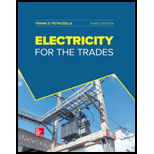
Electricity for the Trades
3rd Edition
ISBN: 9781260437386
Author: Petruzella, Frank
Publisher: MCGRAW-HILL HIGHER EDUCATION
expand_more
expand_more
format_list_bulleted
Textbook Question
Chapter 4.2, Problem 8RQ
Compare a closed and an open electric circuit.
Expert Solution & Answer
Want to see the full answer?
Check out a sample textbook solution
Students have asked these similar questions
L
✓
30 UF
2mtt
The voltage applied across 3-branched circuit of figure 2 is given by v = 100 sin(5000t+ π/4).
Calculate the branch currents and total current.
v 25ŹR
00
10 mA
2 ΚΩ
2 ΚΩ
6 ΚΩ
x
+
ww
4 ΚΩ
4 ΚΩ
+1
2 V
Find Vx,V1,V3,V0 according to the case of the circuits using KVL
Chapter 4 Solutions
Electricity for the Trades
Ch. 4.1 - What is the practical unit of electric charge?Ch. 4.1 - Prob. 2RQCh. 4.1 - Prob. 3RQCh. 4.1 - Explain what a current flow of 1 ampere can be...Ch. 4.1 - Account for the fact that electric current travels...Ch. 4.1 - Prob. 6RQCh. 4.1 - Prob. 7RQCh. 4.1 - Prob. 8RQCh. 4.1 - Prob. 9RQCh. 4.1 - Prob. 10RQ
Ch. 4.1 - Prob. 11RQCh. 4.1 - Prob. 12RQCh. 4.1 - What is the cause and effect of resistance?Ch. 4.1 - When using an ohmmeter to measure resistance, what...Ch. 4.1 - Convert the following data: a. 12,000 A to kA b....Ch. 4.1 - Prob. 16RQCh. 4.2 - Define electric power.Ch. 4.2 - What is the basic unit used to measure electric...Ch. 4.2 - A toaster draws 8 amperes when connected to a...Ch. 4.2 - Prob. 4RQCh. 4.2 - Prob. 5RQCh. 4.2 - Prob. 6RQCh. 4.2 - Prob. 7RQCh. 4.2 - Compare a closed and an open electric circuit.Ch. 4.2 - Prob. 9RQCh. 4.2 - What does Ohms law tell us about current flow in a...Ch. 4.2 - Ohms law is applied to a circuit using what three...Ch. 4.2 - Prob. 12RQCh. 4.2 - Prob. 13RQCh. 4.2 - Prob. 14RQCh. 4.2 - Prob. 15RQCh. 4.2 - Prob. 16RQCh. 4.2 - Prob. 17RQCh. 4.2 - Prob. 18RQ
Knowledge Booster
Learn more about
Need a deep-dive on the concept behind this application? Look no further. Learn more about this topic, electrical-engineering and related others by exploring similar questions and additional content below.Similar questions
- Two loads connected in parallel consume a total of 2.4 kW with a power factor of 0.8 lagging, both supplied at 120 V, 60 Hz. Knowing that one of the loads consumes 1.5 kW at a power factor of 0.707 lagging. a. Determine a power factor of he second load b. Correct the power factor to 0,9 laggingarrow_forwardDetermine the maximum power that a load connected between a and b could consume.arrow_forwardFind Vx,V1,V3,V0 according to the case of the circuits using LVKarrow_forward
arrow_back_ios
SEE MORE QUESTIONS
arrow_forward_ios
Recommended textbooks for you
 EBK ELECTRICAL WIRING RESIDENTIALElectrical EngineeringISBN:9781337516549Author:SimmonsPublisher:CENGAGE LEARNING - CONSIGNMENT
EBK ELECTRICAL WIRING RESIDENTIALElectrical EngineeringISBN:9781337516549Author:SimmonsPublisher:CENGAGE LEARNING - CONSIGNMENT

EBK ELECTRICAL WIRING RESIDENTIAL
Electrical Engineering
ISBN:9781337516549
Author:Simmons
Publisher:CENGAGE LEARNING - CONSIGNMENT
02 - Sinusoidal AC Voltage Sources in Circuits, Part 1; Author: Math and Science;https://www.youtube.com/watch?v=8zMiIHVMfaw;License: Standard Youtube License